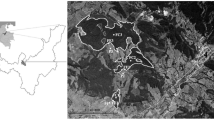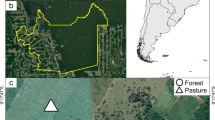Abstract
This study examines the spread of synanthropogenic dung beetles (species favoured by human activities) in pasture landscapes in Central America, and evaluates the role of forest fragments and regenerating patches of native vegetation in maintaining beetle diversity. Pitfall trapping was carried out at nine locations in El Salvador and seven in Atlantic Nicaragua that included both pasture and remnant or regenerating native vegetation. More dung beetle species occurred in forest fragments than in pastures. Community composition differed considerably between forest fragments from El Salvador and Nicaragua with many species restricted to either the Caribbean or Pacific regions. In contrast, dung beetle community composition and structure were largely the same in the pastures of El Salvador and Nicaragua, regardless of region or original habitat-type, and were similar to published results from pastures in Mexico and elsewhere on the Isthmus. Very small patches of native shrubs and tree stands (<2.5 ha) maintained no forest specialists in Nicaragua, whereas, in El Salvador, some forest specialists occurred even in the smallest stands of trees (ca. 0.25 ha). The study indicates that the expansion of cattle pastures has caused a regional decline in dung beetle diversity. Forest fragments and small isolated patches of native trees and shrubs maintain some of the diversity of the original landscape but their conservation value for dung beetles will depend on the biogeographical history of the sites.



Similar content being viewed by others
References
Antongiovanni M, Metzger JP (2005) Influence of matrix habitats on the occurrence of insectivorous bird species in Amazonian forest fragments. Biol Conserv 122:441–451
Avendaño-Mendosa C, Morón-Ríos A, Cano EB, León-Cortés J (2005) Dung beetle community (Coleoptera: Scarabaeidae: Scarabaeinae) in a tropical landscape at the Lachua region, Guatemala. Biodivers Conserv 14:801–822
Barrantes G, Pereira A (2002) Seed dissemination by frugivorous birds from forest fragments to adjacent pastures on the western slope of Volcán Barva, Costa Rica. Rev Biol Trop 50:569–575
Breshears DD, Nylan JW, Heil CE, Wilcox BP (1998) Effects of woody plants on microclimate in a semiarid woodland: soil temperature and evaporation in canopy and intercanopy patches. Int J Plant Sci 159:1010–1017
Brotons L, Monkkonen M, Martin JL (2003) Are fragments islands? Landscape context and density-area relationships in boreal forest birds. Am Nat 162:343–357
Daily GC, Ehrlich PR (1995) Preservation of diversity in small rain-forest patches – rapid evaluations using butterfly trapping. Biodivers Conserv 4:35–55
Davis AJ, Holloway JD, Huijbregts H, Krikken J, Kirk-Spriggs AH, Sutton SL (2001) Dung beetles as indicators of change in the forests of northern Borneo. J Appl Ecol 38:593–616
Doube BM (1990) A functional classification for analysis of the structure of dung beetle assemblages. Ecol Entomol 15:371–383
Estrada A, Anzures DA, Coates-Estrada R (1999) Tropical rain forest fragmentation, Howler monkeys (Alouatta palliata), and dung beetles at Los Tuxtlas, Mexico. Am J Primatol 48:253–262
Estrada A, Coates-Estrada R, Meritt D (1994) Non-flying mammals and landscape changes in the tropical rain-forest region of Los Tuxtlas, Mexico. Ecography 17:229–241
Estrada A, Coates-Estrada R, Anzures Dadda A, Cammarano P (1998) Dung and carrion beetles in tropical rain forest fragments and agricultural habitats at Los Tuxtlas, Mexico. J Trop Ecol 14:577–593
Everitt BS, Dunn G (1991) Applied multivariate data analysis. Edward Arnold, London
Feer F, Hingrat Y (2005) Effects of forest fragmentation on a dung beetle community in French Guiana. Conserv Biol 19:1103–1112
Flores Rodas M (1976) Conservación forestal en el Istmo: problemas principales y necesidades. Rev Biol Trop 24:177–186
Geist HJ, Lambin EF (2002) Proximate causes and underlying driving forces of tropical deforestation. BioSciences 52:143–150
Gill B (1991) Dung beetles in tropical American forests. In: Hanski I, Cambefort Y (eds) Dung beetle ecology. Princeton University Press, New Jersey, pp 283–303
Gillespie TW (1999) Life history characteristics and rarity of woody plants in tropical dry forest fragments of Central America. J Trop Ecol 15:637–649
Glomsrød S, Monge AMD, Vennemo H (1997) Structural adjustment and deforestation in Nicaragua. Statistics Norway Research Department, Discussion Paper 193, pp 1–26
Halffter G, Arellano L (2002) Response of dung beetle diversity to human-induced changes in a tropical landscape. Biotropica 32:144–154
Hanski I (1991) North temperate dung beetles. In: Hanski I, Cambefort Y (eds) Dung beetle ecology, Princeton University Press, New Jersey, pp 75–96
Harvey CA, Gonzalez J, Somarriba E (2006) Dung beetle and terrestrial mammal diversity in forests, indigenous agroforestry systems and plantain monocultures in Talamanca, Costa Rica. Biodivers Conserv 15:555–585
Hernández B, Maes J-M, Harvey CA, Vílchez S, Medina A, Sánchez D (2003) Abundancia y diversidad de escarabajos coprófagos y mariposas diurnas en un paisaje ganadero en el departamento de Rivas, Nicaragua. Agroforest Am 39/40:93–101
Horgan FG, (1999) APSO’s cooperation with URACCAN and IREMADES: supporting environmental initiatives on Nicaragua’s Atlantic coast. Special service overseas report to APSO Irish Technical Cooperation in Central America, pp 75
Horgan FG (2001) Burial of bovine dung by coprophagous beetles (Coleoptera: Scarabaeidae) from horse and cow grazing sites in El Salvador. Eur J Soil Biol 37:103–111
Horgan FG (2002) Shady field boundaries and the colonisation of dung by coprophagous beetles in Central American pastures. Agric, Ecosyst Environ 91:25–36
Horgan FG (2005) Effects of deforestation on diversity, biomass and function of dung beetles on the eastern slopes of the Peruvian Andes. For Ecol Manage 216:117–133
Klein BC (1989) Effects of forest fragmentation on dung and carrion beetle communities in central Amazonia. Ecology 70:1715–1725
Kohlmann B (1994) A preliminary study of the invasion and dispersal of Digitonthophagus gazella (Fabricius, 1787) in Mexico (Coleoptera: Scarabaeidae: Scarabaeinae). Acta Zool Mex (n.s.) 61:35–42
Kohlmann B, Solís A (1997) El genero Dichotomius (Coleoptera: Scarabaeidae) en Costa Rica. Giorn Ital Entomol 8:343–382
Komar O (2002) Priority conservation areas for birds in El Salvador. Anim Conserv 5:173–183
Koop G, Tole L (1997) Measuring differential forest outcomes: a tale of two countries. World Dev 25:2043–2056
Lobo JM, Montes de Oca E (1994) Distribución local y coexistencia de Digitonthophagus gazella (Fabricius, 1787) y Onthophagous batesi Howden & Carthwright, 1963 (Coleoptera: Scarabaeidae). Elytron 8:117–127
Ludwig JA, Reynolds JF (1988) Statistical ecology: a primer on methods and computing. John Wiley & Sons, Toronto
Martínez-Garza C, González-Montagut R (1999) Seed rain from forest fragments into tropical pastures in Los Tuxtlas, Mexico. Plant Ecol 145:255–265
Martínez MI, Cruz-R. M, Lumaret J-P (2000) Efecto del diferente manejo de los pastizales y del ganado sobre los escarabajos coprófagos Ataenius apicalis Hinton y Ataenius sculptor Harold (Scarabaeidae: Aphodinae: Eupariini). Acta Zool Mex (n.s.) 80:185–196
Montes de Oca E, Halffter G (1995) Daily and seasonal activities of a guild of the coprophagous, burrowing beetle (Coleoptera Scarabaeidae Scarabaeinae) in tropical grasslands. Trop Zool 8:159–180
Morelli E, Gonzales-Vainer P, Baz A (2002) Coprophagous beetles (Coleoptera: Scarabaeoidae) in Uruguayan prairies: abundance, diversity and seasonal occurrence. Stud Neotrop Fauna Environ 37:53–57
Myrcha A, Andrzejewska L (1984) Bioenergetics of the developmental period of the coprophagous beetles of Panamanian pastures. Ekol Pol 32:219–244
Peck SB, Howden HF (1984) Response of a dung beetle guild to different sizes of dung bait in a Panamanian rainforest. Biotropica 16:235–238
Pither R, Kellman M (2002) Tree species diversity in small, tropical riparian forest fragments in Belize, Central America. Biodivers Conserv 11:1623–1636
Powell GVN, Bjork RN (2004) Habitat linkages and the conservation of tropical biodiversity as indicated by seasonal migrations of three-wattled bellbirds. Conserv Biol 18:500–509
Rudel T, Roper J (1997) The paths to rainforest destruction: cross-national patterns of tropical deforestation, 1975–1990. World Dev 25:53–65
Sax DF, Gaines SD (2003) Species diversity: from global decreases to local increases. Trends Ecol Evol 18:561–566
Scheffler PY (2005) Dung beetle (Coleoptera : Scarabaeidae) diversity and community structure across three disturbance regimes in eastern Amazonia. J Trop Ecol 21:9–19
Secretaria de Integración Económica Centroamericana (2002) Estudio comercial descriptivo de carnes en Centroamérica. Internal SIECA report, pp 49
Solís AA (1987) Los escarabajos (Coleoptera: Scarabaeidae: Scarabaeinae) de la Estación Rio San Lorencito, Reserva Forestal de San Ramón, Costa Rica. Brenesia 27:81–111
Turner IM, Corlett RT (1996) The conservation value of small, isolated fragments of lowland tropical rain forest. Trends Ecol Evol 11:330–333
Usher MB (1986) Wildlife conservation evaluation: attributes, criteria and values. In: Usher MB (eds) Wildlife conservation evaluation. Chapman and Hall, London, pp 3–44
Acknowledgements
The author thanks the Agronomy Faculty of the University of El Salvador for access and transport to the Comalapa field site, the land owners who allowed access to their properties in El Salvador and Nicaragua, APSO-Cooperación Técnica Irlandesa for support during an SSO-Assignment to Nicaragua, Vilma Valencia Duran for help with Salvadoran field surveys, Enio Cano, François Génier, Bruce Gill, and Angel Solís for help in beetle identification; Mary Coffey, Norma O’Hea, Dan Quiring and two anonymous reviewers for many helpful suggestions that improved the manuscript; and students and staff at La Universidad de las Regiones Autónomas de la Costa Caribe Nicaragüense (URACCAN) for their support and interest.
Author information
Authors and Affiliations
Corresponding author
Rights and permissions
About this article
Cite this article
Horgan, F.G. Dung beetles in pasture landscapes of Central America: proliferation of synanthropogenic species and decline of forest specialists. Biodivers Conserv 16, 2149–2165 (2007). https://doi.org/10.1007/s10531-006-9145-3
Received:
Accepted:
Published:
Issue Date:
DOI: https://doi.org/10.1007/s10531-006-9145-3




